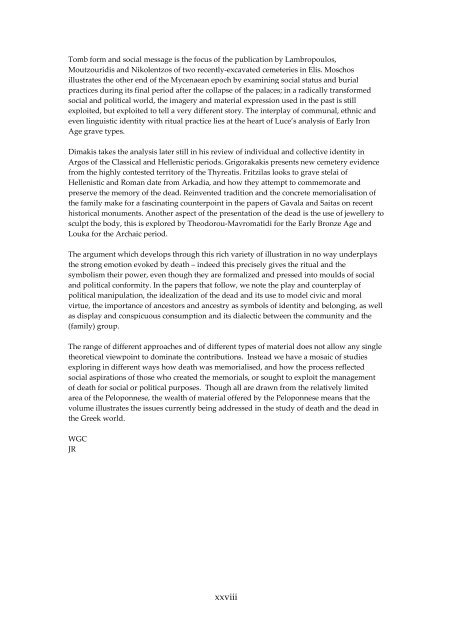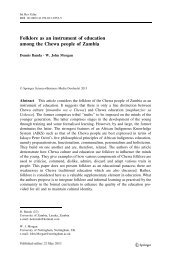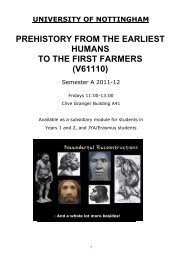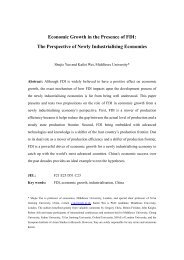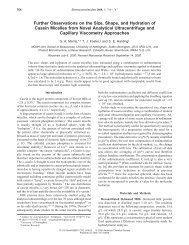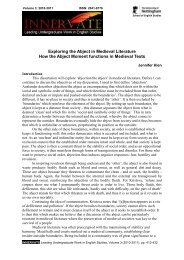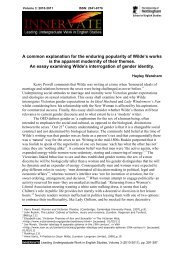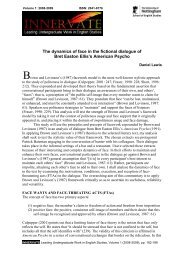Honouring the Dead in the Peloponnese - University of Nottingham
Honouring the Dead in the Peloponnese - University of Nottingham
Honouring the Dead in the Peloponnese - University of Nottingham
You also want an ePaper? Increase the reach of your titles
YUMPU automatically turns print PDFs into web optimized ePapers that Google loves.
Tomb form and social message is <strong>the</strong> focus <strong>of</strong> <strong>the</strong> publication by Lambropoulos,<br />
Moutzouridis and Nikolentzos <strong>of</strong> two recently-excavated cemeteries <strong>in</strong> Elis. Moschos<br />
illustrates <strong>the</strong> o<strong>the</strong>r end <strong>of</strong> <strong>the</strong> Mycenaean epoch by exam<strong>in</strong><strong>in</strong>g social status and burial<br />
practices dur<strong>in</strong>g its f<strong>in</strong>al period after <strong>the</strong> collapse <strong>of</strong> <strong>the</strong> palaces; <strong>in</strong> a radically transformed<br />
social and political world, <strong>the</strong> imagery and material expression used <strong>in</strong> <strong>the</strong> past is still<br />
exploited, but exploited to tell a very different story. The <strong>in</strong>terplay <strong>of</strong> communal, ethnic and<br />
even l<strong>in</strong>guistic identity with ritual practice lies at <strong>the</strong> heart <strong>of</strong> Luce’s analysis <strong>of</strong> Early Iron<br />
Age grave types.<br />
Dimakis takes <strong>the</strong> analysis later still <strong>in</strong> his review <strong>of</strong> <strong>in</strong>dividual and collective identity <strong>in</strong><br />
Argos <strong>of</strong> <strong>the</strong> Classical and Hellenistic periods. Grigorakakis presents new cemetery evidence<br />
from <strong>the</strong> highly contested territory <strong>of</strong> <strong>the</strong> Thyreatis. Fritzilas looks to grave stelai <strong>of</strong><br />
Hellenistic and Roman date from Arkadia, and how <strong>the</strong>y attempt to commemorate and<br />
preserve <strong>the</strong> memory <strong>of</strong> <strong>the</strong> dead. Re<strong>in</strong>vented tradition and <strong>the</strong> concrete memorialisation <strong>of</strong><br />
<strong>the</strong> family make for a fasc<strong>in</strong>at<strong>in</strong>g counterpo<strong>in</strong>t <strong>in</strong> <strong>the</strong> papers <strong>of</strong> Gavala and Saitas on recent<br />
historical monuments. Ano<strong>the</strong>r aspect <strong>of</strong> <strong>the</strong> presentation <strong>of</strong> <strong>the</strong> dead is <strong>the</strong> use <strong>of</strong> jewellery to<br />
sculpt <strong>the</strong> body, this is explored by Theodorou-Mavromatidi for <strong>the</strong> Early Bronze Age and<br />
Louka for <strong>the</strong> Archaic period.<br />
The argument which develops through this rich variety <strong>of</strong> illustration <strong>in</strong> no way underplays<br />
<strong>the</strong> strong emotion evoked by death – <strong>in</strong>deed this precisely gives <strong>the</strong> ritual and <strong>the</strong><br />
symbolism <strong>the</strong>ir power, even though <strong>the</strong>y are formalized and pressed <strong>in</strong>to moulds <strong>of</strong> social<br />
and political conformity. In <strong>the</strong> papers that follow, we note <strong>the</strong> play and counterplay <strong>of</strong><br />
political manipulation, <strong>the</strong> idealization <strong>of</strong> <strong>the</strong> dead and its use to model civic and moral<br />
virtue, <strong>the</strong> importance <strong>of</strong> ancestors and ancestry as symbols <strong>of</strong> identity and belong<strong>in</strong>g, as well<br />
as display and conspicuous consumption and its dialectic between <strong>the</strong> community and <strong>the</strong><br />
(family) group.<br />
The range <strong>of</strong> different approaches and <strong>of</strong> different types <strong>of</strong> material does not allow any s<strong>in</strong>gle<br />
<strong>the</strong>oretical viewpo<strong>in</strong>t to dom<strong>in</strong>ate <strong>the</strong> contributions. Instead we have a mosaic <strong>of</strong> studies<br />
explor<strong>in</strong>g <strong>in</strong> different ways how death was memorialised, and how <strong>the</strong> process reflected<br />
social aspirations <strong>of</strong> those who created <strong>the</strong> memorials, or sought to exploit <strong>the</strong> management<br />
<strong>of</strong> death for social or political purposes. Though all are drawn from <strong>the</strong> relatively limited<br />
area <strong>of</strong> <strong>the</strong> <strong>Peloponnese</strong>, <strong>the</strong> wealth <strong>of</strong> material <strong>of</strong>fered by <strong>the</strong> <strong>Peloponnese</strong> means that <strong>the</strong><br />
volume illustrates <strong>the</strong> issues currently be<strong>in</strong>g addressed <strong>in</strong> <strong>the</strong> study <strong>of</strong> death and <strong>the</strong> dead <strong>in</strong><br />
<strong>the</strong> Greek world.<br />
WGC<br />
JR<br />
xxviii


